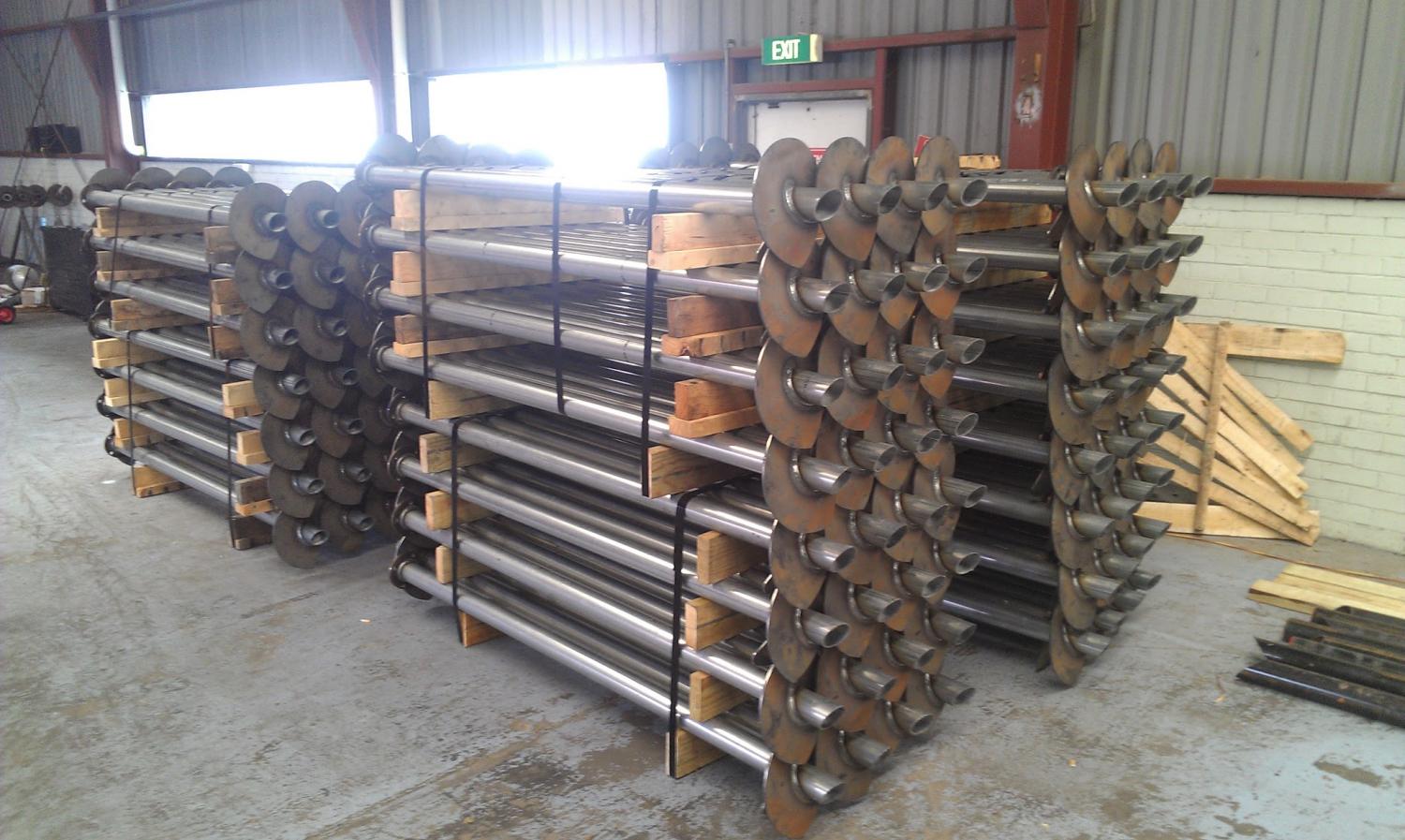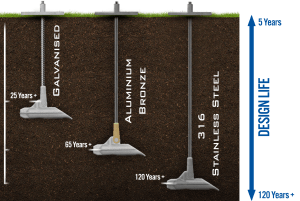Just How Durable Earth Anchors Work: A Comprehensive Guide to Dirt Anchoring Solutions
Sturdy Earth supports play a vital role in providing stability and support in numerous building applications. By embedding deeply into the ground, they withstand upright and side pressures efficiently. Various kinds of supports accommodate various soil problems, making them flexible. Comprehending their auto mechanics and setup techniques is necessary for taking full advantage of performance. What aspects affect their efficiency, and just how do they compare to conventional techniques? The answers might amaze you.
Comprehending Durable Earth Anchors
Sturdy Earth supports act as essential parts in various building and construction and landscape design tasks, supplying security and support in challenging dirt conditions. These supports operate by being embedded into the ground, where they resist upright and side forces. Their style enables safe and secure attachment to frameworks, guaranteeing they remain anchored against dirt motion or outside loads.The performance of durable Earth supports greatly relies on the sort of dirt and the support's setup deepness. Correct installment strategies are critical, as they determine the anchor's holding capability. Environmental factors, such as wetness and freeze-thaw cycles, can also influence performance.These supports are often used in applications ranging from protecting fencings and retaining walls to maintaining momentary structures throughout negative weather. Recognizing the principles behind heavy-duty Earth anchors is necessary for experts seeking to improve the longevity and safety of their jobs.
Types of Heavy-Duty Earth Anchors
Numerous kinds of sturdy Earth supports are developed to satisfy certain needs based upon soil problems and job demands. Helical anchors, including screw-like blades, are effective in softer dirts, supplying high load abilities and easy installation. Driven anchors, which are hammered into the ground, appropriate for rough surfaces and give instant tons assistance. Tie-back anchors are generally made use of in maintaining wall surface applications, allowing for lateral support by securing right into the ground at an angle. Another type is the cast-in-place anchor, suitable for concrete applications, as they are integrated right into structures for boosted stability. Lastly, soil screw anchors are flexible choices that can be used in numerous dirt types, providing reliable stress and compression abilities. Each kind offers distinctive applications, making sure security and security in building and construction and landscape design projects. Comprehending these choices enables notified decisions in choosing the ideal Earth anchoring solution.
The Mechanics of Soil Anchoring

Understanding the mechanics of soil anchoring needs an exam of numerous types of Earth anchors and their installment methods. Each support type presents special attributes that affect its effectiveness in various dirt problems. Correct installation methods are important for making best use of the securing system's security and performance.
Kinds of Earth Anchors
Earth supports, important elements in dirt anchoring systems, can be found in a number of types, each developed for particular applications and soil problems. One of the most usual types include screw anchors, which are turned into the ground, offering solid side resistance. Helical supports include blades that enable effective installation in various soil kinds, making them suitable for both short-term and irreversible applications. Driven anchors, usually made from steel, are hammered right into the dirt and are reliable in rough or thick atmospheres. Auger anchors utilize a helical layout to facilitate setup in softer soils. Plate supports consist of a level plate buried flat, dispersing lots over a bigger area, perfect for applications needing high load capabilities in natural soils.
Setup Strategies Clarified
Appropriate installment methods are crucial for the performance of dirt anchoring systems. The process generally starts with site assessment, confirming the picked location can support the support's load. After figuring out the right anchor type, correct opening deepness and angle need to be developed. The setup involves driving the support right into the ground making use of customized equipment, such as hydraulic or manual chauffeurs, to accomplish best embedment. Post-installation, tensioning the support is critical to assure security; this is frequently confirmed with lots screening. Furthermore, surrounding dirt problems need to be monitored to avoid variation. Following these methods not just boosts the anchor's efficiency however additionally lengthens its life-span, giving reputable support for various applications.
Applications of Heavy-Duty Earth Anchors
While heavy-duty Earth supports are commonly connected with construction and landscape design, their adaptability extends to a range of applications throughout various industries. In civil engineering, they offer important assistance for maintaining wall surfaces, making sure stability in areas susceptible to dirt disintegration. The aquatic field utilizes these supports for safeguarding docks and marinas, protecting against motion triggered by currents and tides. In addition, in the telecommunications industry, heavy-duty Earth anchors are substantial for maintaining cell towers and other high frameworks against wind pressures. Agricultural applications likewise benefit, as these anchors can protect frameworks like greenhouses and livestock fencing, ensuring they stand up to rough climate condition. In renewable energy tasks, such as wind farms, Earth anchors play an important function in securing turbine structures, boosting general safety and efficiency. This broad variety of applications highlights the adaptability and dependability of sturdy Earth supports across various areas.
Benefits Over Typical Anchoring Approaches
Typical anchoring approaches have long been relied upon for security, durable Earth supports offer significant benefits that boost efficiency and performance. One major advantage is their superior load-bearing ability, which enables them to withstand better pressures without failure. This toughness makes them suitable for demanding applications, such as in construction and energy installations.Additionally, durable Earth anchors are designed for much deeper installation, providing greater security in numerous soil problems, including loosened try this site or sandy dirts. Their resistance to deterioration and ecological elements assures a longer life-span and decreased upkeep prices compared to traditional methods.Moreover, these supports can be mounted with minimal disruption to the surrounding area, protecting the stability of the landscape. Generally, durable Earth supports present a reputable and reliable solution for securing needs, going beyond the limitations typically connected with typical anchoring methods.
Setup Refine and Finest Practices
The installment procedure for dirt securing solutions begins with comprehensive preparation and site analysis to guarantee peak performance. Following this, a detailed installment guide offers clear instructions for reliable execution (soil anchoring solutions). Following these ideal methods is important for accomplishing resilient and trustworthy anchoring outcomes
Prep Work and Site Assessment
Effective preparation and complete site assessment are essential actions in the installation of soil securing remedies. Prior to installment, the soil kind need to be evaluated to identify its bearing ability and suitability for securing. Conducting a geotechnical study can supply essential info concerning dirt structure, dampness levels, and prospective ground motion. Additionally, identifying existing frameworks, plant life, and utilities is necessary to prevent interference throughout installment. The location ought to be free from particles and obstacles to ensure safe accessibility for devices. Weather must also be checked, as unfavorable problems can influence both security and setup efficiency. By diligently preparing the website and evaluating all appropriate factors, the probability of successful support performance is considerably boosted.
Step-by-Step Setup Guide
A detailed installment procedure is crucial for accomplishing excellent efficiency of soil securing solutions. The installment begins with selecting the appropriate support kind and ensuring the site is clear of particles. Next, proper opening placement is determined based on tons demands. When the place is developed, openings are pierced to the specified deepness and size utilizing the correct tools. The anchor is then put right into the opening, ensuring it is aligned properly. After protecting the support, soil is backfilled and compressed to improve stability. It is vital to follow manufacturer guidelines throughout the process. A post-installation assessment confirms that the anchors are effectively located and functioning as meant, supplying reliable support for the intended application.

Maintenance and Examination of Earth Anchors
Normal upkeep and assessment of Earth anchors are important for ensuring long-lasting performance and stability. Routine checks permit the very early discovery of problems such as rust, loosening up, or dirt motion. Assessors should look for signs of rust or destruction on the support components, specifically at the connection factors. Furthermore, the bordering dirt should be evaluated for erosion or modifications in check my source moisture material, which can impact support effectiveness.It is a good idea to establish a routine assessment routine, preferably a minimum of annually, depending on ecological conditions. During evaluations, all visible parts need to be cleaned to eliminate dust or particles that might hide prospective issues. Any kind of indications of distress, such as turning frameworks or uncommon settling, must motivate immediate evaluation. Appropriate paperwork of assessments can help in tracking anchor performance in time and help with prompt upkeep actions, making sure the anchors stay useful and trusted.
Frequently Asked Inquiries
What Products Are Heavy-Duty Earth Anchors Normally Made From?
Durable Earth anchors are normally constructed from sturdy materials such as galvanized steel or stainless-steel, ensuring toughness and resistance to corrosion. These visit their website products give lasting support and security in different soil conditions and applications.
How Do Soil Problems Impact Anchor Performance?
Soil conditions substantially affect support performance. Elements such as soil type, dampness content, and compaction impact the anchor's grasp and stability, with cohesive soils commonly giving better resistance than loosened or sandy dirts, influencing overall efficiency.
Can Heavy-Duty Earth Anchors Be Recycled After Elimination?
Durable Earth anchors can be reused after elimination, given they are checked for damage and wear. Correct cleaning and maintenance boost their durability, making certain efficient performance in subsequent setups when problems permit safe reinstallation.
What Are the Environmental Effects of Using Earth Anchors?
The environmental impacts of making use of Earth anchors include possible soil disruption, disruption of local ecosystems, and possible contamination of groundwater. However, if used sensibly, their benefits typically outweigh these concerns, advertising stability in numerous applications.
Exactly how Do I Pick the Right Support for My Job?
